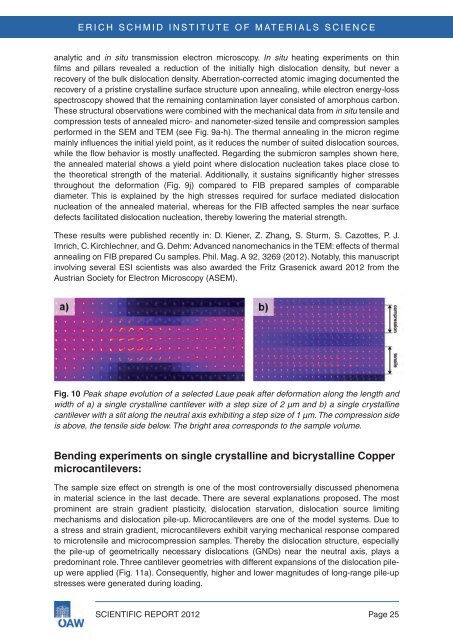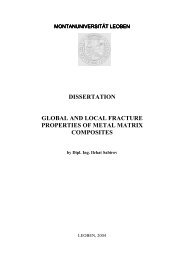Scientific Advisory Board - Erich Schmid Institute
Scientific Advisory Board - Erich Schmid Institute
Scientific Advisory Board - Erich Schmid Institute
Create successful ePaper yourself
Turn your PDF publications into a flip-book with our unique Google optimized e-Paper software.
ERICH SCHMID INSTITUTE OF MATERIALS SCIENCE<br />
analytic and in situ transmission electron microscopy. In situ heating experiments on thin<br />
films and pillars revealed a reduction of the initially high dislocation density, but never a<br />
recovery of the bulk dislocation density. Aberration-corrected atomic imaging documented the<br />
recovery of a pristine crystalline surface structure upon annealing, while electron energy-loss<br />
spectroscopy showed that the remaining contamination layer consisted of amorphous carbon.<br />
these structural observations were combined with the mechanical data from in situ tensile and<br />
compression tests of annealed micro- and nanometer-sized tensile and compression samples<br />
performed in the Sem and tem (see fig. 9a-h). the thermal annealing in the micron regime<br />
mainly influences the initial yield point, as it reduces the number of suited dislocation sources,<br />
while the flow behavior is mostly unaffected. Regarding the submicron samples shown here,<br />
the annealed material shows a yield point where dislocation nucleation takes place close to<br />
the theoretical strength of the material. Additionally, it sustains significantly higher stresses<br />
throughout the deformation (fig. 9j) compared to fiB prepared samples of comparable<br />
diameter. this is explained by the high stresses required for surface mediated dislocation<br />
nucleation of the annealed material, whereas for the fiB affected samples the near surface<br />
defects facilitated dislocation nucleation, thereby lowering the material strength.<br />
these results were published recently in: d. Kiener, Z. Zhang, S. Sturm, S. cazottes, p. J.<br />
imrich, c. Kirchlechner, and g. dehm: Advanced nanomechanics in the tem: effects of thermal<br />
annealing on fiB prepared cu samples. phil. mag. A 92, 3269 (2012). notably, this manuscript<br />
involving several eSi scientists was also awarded the fritz grasenick award 2012 from the<br />
Austrian Society for electron microscopy (ASem).<br />
Fig . 10 Peak shape evolution of a selected Laue peak after deformation along the length and<br />
width of a) a single crystalline cantilever with a step size of 2 µm and b) a single crystalline<br />
cantilever with a slit along the neutral axis exhibiting a step size of 1 µm. The compression side<br />
is above, the tensile side below. The bright area corresponds to the sample volume.<br />
Bending experiments on single crystalline and bicrystalline Copper<br />
microcantilevers:<br />
the sample size effect on strength is one of the most controversially discussed phenomena<br />
in material science in the last decade. there are several explanations proposed. the most<br />
prominent are strain gradient plasticity, dislocation starvation, dislocation source limiting<br />
mechanisms and dislocation pile-up. microcantilevers are one of the model systems. due to<br />
a stress and strain gradient, microcantilevers exhibit varying mechanical response compared<br />
to microtensile and microcompression samples. thereby the dislocation structure, especially<br />
the pile-up of geometrically necessary dislocations (gnds) near the neutral axis, plays a<br />
predominant role. three cantilever geometries with different expansions of the dislocation pileup<br />
were applied (fig. 11a). consequently, higher and lower magnitudes of long-range pile-up<br />
stresses were generated during loading.<br />
<strong>Scientific</strong> RepoRt 2012 page 25

















